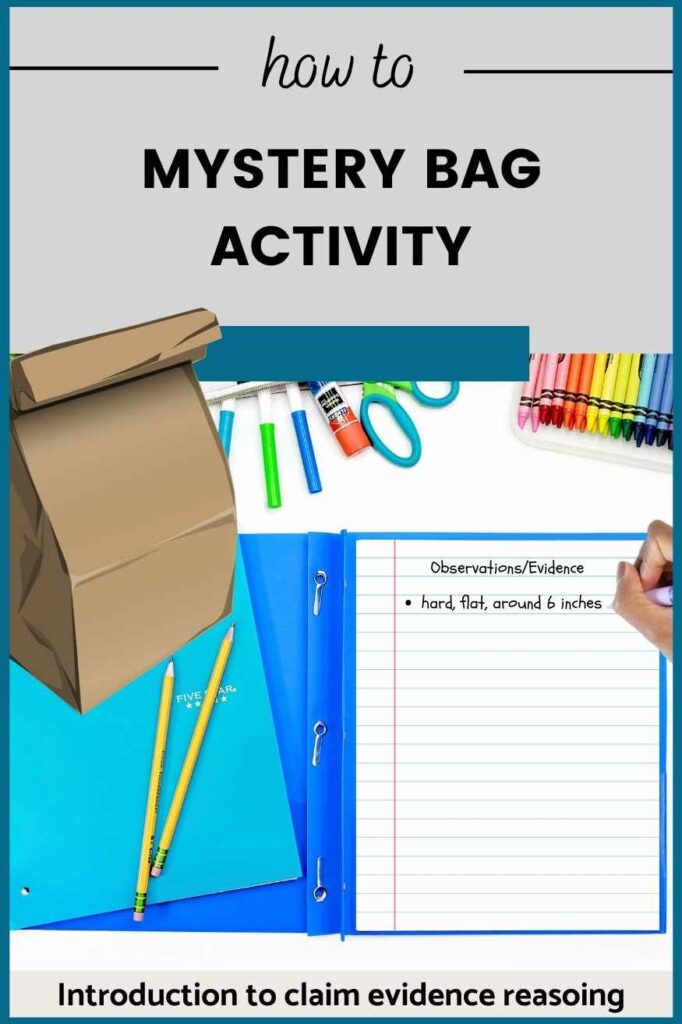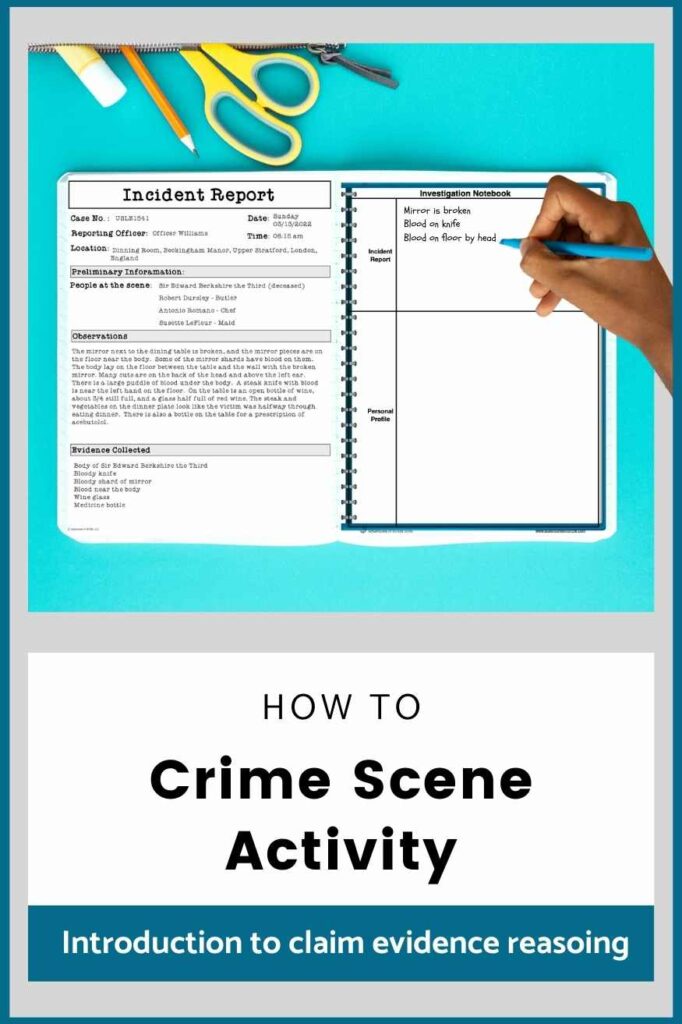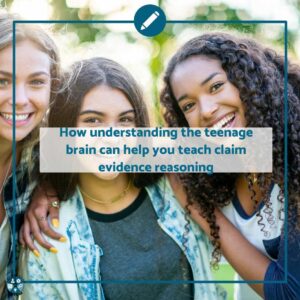Claim evidence reasoning scientific explanations are difficult for many students. One way you can introduce this form of writing and have fun in the process is through mysteries. Students love trying to solve things, so why not use that love to introduce them to writing their claim evidence reasoning.
Claim Evidence Reasoning Activity One: Mystery Bag Challenge
In this quick hands-on activity, students become detectives of their own as they analyze random school objects concealed in a closed bag. Using their sense of touch, sound, and smell, they record observations as evidence. They then make claims about the objects’ identities and support their claims with the collected evidence. Engaging in academic discussions, groups with similar bags but different claims compare and refine their reasoning skills.

Here is how this claim evidence reasoning activity works.
- Set up: students are given a closed brown bag with two to three objects in it. Examples could be pencils, paper clips, stapler (without the staples), ruler, eraser, rubber bands… Make sure you have two to three sets of each bag type so that the same items will be observed by multiple groups.
- For a class with eight groups, you might have only two sets of four different bags.
- Students are told that they cannot open the bag, but they can use their sense of touch, sound, and smell to record observations. These observations will be their evidence.
- Students will use their evidence to make a claim as to what objects are in the bag.
- They will then support their claim with evidence from their observations.
- They will use reasoning, their explanation as to how the observations lead them to believe which objects were in their claims.
- They then share out their discoveries.
- Groups that had the same bag numbers but different claims can have academic discussions as to why their claim is correct over the other groups.
- In the end, you can show them what was in each bag.
- Students can then compare the accuracy of their claim and evidence to the actual contents.
Claim Evidence Reasoning Activity Two: Solve the Case
In this activity, students are in the role of investigators as they tackle a captivating crime scene investigation. Present them with a historical mystery, such as the case of Sir Edward Berkshire the Third, through police incident reports, suspect profiles, and forensic reports. Working collaboratively, students analyze the evidence, formulate their claims, and provide supporting evidence. Group discussions promote critical thinking and effective reasoning, leading to well-crafted investigation reports.

Here is how this claim evidence reasoning activity works.
- Begin by setting the stage for the investigation. In the investigation I use I have my students solve the case of Sir Edward Berkshire the Third. I explain that they have been hired by the family to determine what happened to him.
- The students are then given the police incident reports which contain the police log of the crime scene with pictures and observations.
- They go through the reports and write down key observations and details in their journals.
- Next, they are given the suspect profiles. Each profile has a picture and description of the suspect along with information about what they do and where they were when the incident took place.
- Finally, they go through the forensic reports and record key details from those reports into their journals.
- As they gather new information, they discuss with their group what they think happened and who the key suspects are.
- Once they have all of the information, they produce a claim as to what happened to Sir Edward Berkshire the Third and support it with at least two pieces of key evidence from all of the reports.
- The groups share out their answers and then have an academic discussion if different groups have different claims. They have to use the evidence to support their claim and explain which evidence does not support the other groups’ claims.
- After the discussion, the students write up their reports stating their claim using evidence and their reasonings for what happened to support their claim.
Claim Evidence Reasoning Activity Three: Mythical creatures
Challenge students’ analytical skills as they explore mythical creatures from various cultures and legends. Encourage them to research using reliable resources and gather evidence to support or refute the existence of these creatures. Presenting their claims to the class with evidence and reasoning sparks lively discussions, fostering curiosity and creativity.

Here is how this claim evidence reasoning activity works.
- Find some popular mythical creatures that your students would be familiar with. Examples could be dragons, unicorns, mermaids, chupacabra, big foot…
- Have groups choose the mythical creature that they would like to study.
- Students can use different resources, books, websites, and videos to research their creatures. This is a great time to discuss the different types of resources and how to determine if a site is a credible source.
- Students will use their resources to collect evidence that either supports or refutes the existence of their creature. Again, remind students to use reliable sources like eyewitness testimonies, historical records, and scientific explanations.
- Students will present their claims to the class and use their evidence and reasoning to support their claims.
Claim Evidence Reasoning Activity Four: Historical Mysteries
In this activity, students become historical detectives in this thought-provoking activity, where they dive into historical mysteries. Researching historical records, eyewitness testimonies, and scientific explanations, they collect evidence to solve the mysteries. Presenting their claims with well-supported evidence and reasoning enhances critical thinking and historical empathy.

Here is how this claim evidence reasoning activity works.
- Find historical mysteries that students might be familiar with. Examples could be the disappearance of Amelia Earhart, the mysterious crystal skulls, the legend of King Arthur, the location of Cleopatra’s tomb, the mystery of treasure on Oak Island, or the city of Atlantis.
- Have groups choose the historical mystery that they would like to study.
- Students can use different resources, books, websites, and videos to research their creatures. This is a great time to discuss the different types of resources and how to determine if a site is a credible source.
- Students will use their resources to collect evidence to try and solve the mystery. Again, remind students to use reliable sources like eyewitness testimonies, historical records, and scientific explanations.
- Students will present their claims to the class and use their evidence and reasoning to support their claims.
Benefits of using Mysteries to Introduce Claim Evidence Reasonings.
- Hands-on learning: Students are working with actual materials, which helps keep them more engaged.
- Critical Thinking: Students will be analyzing evidence and determining if a source is a reliable source. They will be problem-solving while using factual information to solve the mysteries.
- Collaboration: Students will work on their team building skills and learn to work with other students. To listen to other ideas and perspectives.
- Contextual Learning: Doing these mystery activities helps students see the benefits of science and how it can be used in the real world to solve actual cases and problems.
Introducing claim evidence reasoning through these captivating activities sets the stage for engaging scientific exploration throughout the year. Students will be so engrossed in the excitement of these mysteries that they won’t realize they are honing complex analytical and writing skills. As you refer back to these activities, they will confidently tackle data analysis and writing claim evidence reasoning for less thrilling topics. The journey of discovery and learning awaits your students with these thrilling activities.





